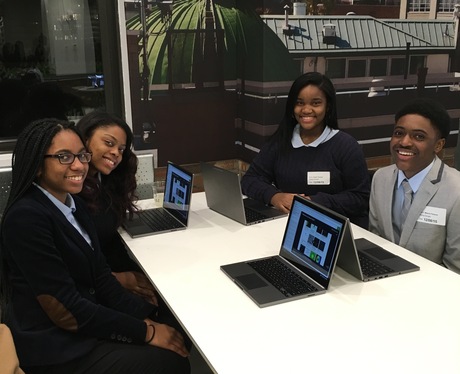Co-authored with Christina Lewis Halpern
 Students from The Opportunity Network take part in an Hour of Code workshop at Google, learning critical computer science skills and networking with engineers.
Students from The Opportunity Network take part in an Hour of Code workshop at Google, learning critical computer science skills and networking with engineers.
Last week, the Google cafeteria served up a new experience to 150 ninth graders from New York City public schools. Along with pizza and cookies, the students got a class in coding from Google's famed engineers. In a statistically unusual scene for the tech world, the students hovering over computer screens were black, Latino and Asian/Pacific Islander. Some are just learning to master English after immigrating; others have limited access to computers in their daily lives.
The hour-long class, which was part of the Computer Science Education Week Hour of Code initiative, offered students a taste of computer engineering and gave them confidence to write computer programs. This is no small accomplishment in a country where so many schools have yet to join the technology revolution. Of the 42,000 high schools in the United States, only 2,100 of them are certified to teach AP computer science.
Computer science education is critical. All Star Code teaches coding in a rigorous, project-based and growth mindset way during our six-week Summer Intensive and in our one-day exposure workshops because coding is empowering, in-demand and a gateway to the tech talent pipeline. Together, we have helped hundreds of students of color prepare to pursue such careers.
However, we can say definitively that while computer science courses are essential, they aren't sufficient to close the gap. The hard fact is that 80 percent of Americans find their jobs through people they know. It's a hidden job market, only visible to those with connections and the know-how to nurture their networks.
Jaime Casap, Google's Education Evangelist, recommends that future techies learn about the field and pursue connections via LinkedIn, industry blogs and Twitter. To do that, they need to understand how to network, be familiar with networking sites like LinkedIn and learn how to strike up and nurture a professional relationship. Only then can they do what Casap says is a real differentiator: "Nothing thrills me more than having a student reach out with passion around the same problems I want to solve."
Students who grew up in families of professionals learn all this through their everyday lives, but others need lessons in how to decrypt the unwritten codes that govern the business ecosystem. The Opportunity Network puts its students through a six-year curriculum that includes paid internships, meetings with professionals and skill-building in professional networks, etiquette and norms. "What is LinkedIn?" is a question we hear often from ambitious students who want to develop their career fluency skills.
This experience is critically important for students interested in tech jobs because success for our students means pioneering into a field where only one percent of VC-backed start-ups have a black or Latino member of the founding team. Aspiring techies need to become as fluent in the workstyles and cultures of Silicon Valley as they are in Java and C++.
Even with these skills, they face what Tristan Walker, founder and CEO of Walker & Company Brands, calls implicit bias. As he explained to Fast Company, "Implicit bias is hiring based solely off employee referrals when your organization isn't very diverse. Implicit bias is requiring whiteboard coding challenges for students at tech firm interviews when they've never experienced this form of interviewing before (and had no one tell them what to expect during these interviews)."
In a recent tweetstorm, Slack CEO Stewart Butterfield gave impassioned testimony about his rise: "I've always been the default. I had unlimited role models, and the path to any of them was always an obvious straight line." Until we help students of color chart their own paths to elite opportunities, we won't have equality.
There are early efforts to begin to turn things around. Tristan Walker's company is majority women and majority minority. He begins each job search by asking investors, colleagues and friends if they know any people of color or women who would excel at those roles. In addition to All Star Code, organizations like Black Girls Code, CODE2040 and Hidden Genius Project have a strong focus on mentors and networks to complement the technical skill training.
These leaders are beginning to fix the broken diversity pipeline. But what we really need is a shared vision that all students need both the skills to code on computers and the skills to decode office cultures so that they can open closed doors, walk through them into new jobs and help make their workplaces more hospitable to diverse employees.
If we achieve this, some of the ninth graders who tried coding at Google last week will return to that corporate cafeteria in ten years, as Google employees, and find it filled with the same diverse mix of people they sat with for a special hour in 2015.
Christina Lewis Halpern is the Founder and Executive Director of All Star Code, a non-profit education organization that attracts, prepares and places more young men of color in the technology sector.
Jessica Pliska is the Founder and CEO of The Opportunity Network, a non-profit organization that invests in low-income high school students to ensure their college and career success.